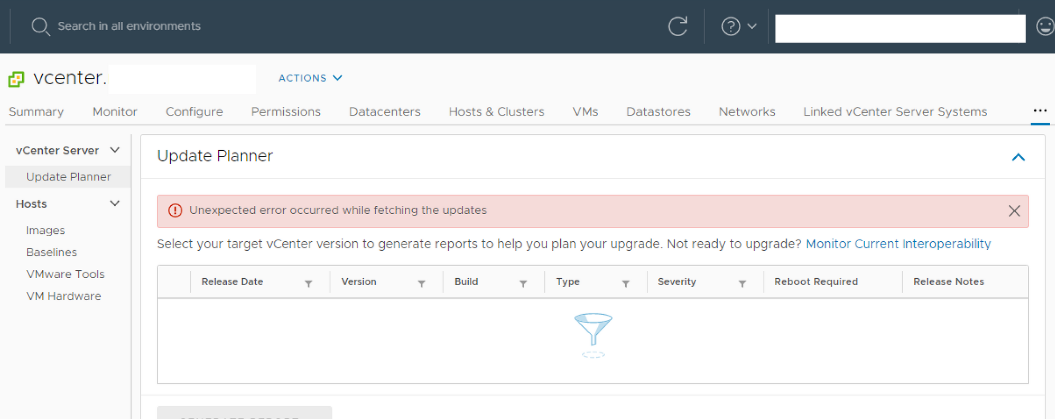This article discusses the issue of vCenter 7 unexpected error occurred while fetching the updates. You could also find the secure way to protect your VCSA when updating.


Update Planner is part of vSphere Lifecycle Manager used to facilitate vCenter Server updates. When you use the Update Planner in the vSphere Client, you might see: Unexpected error occurred while fetching the updates. So this article offers 2 ways to solve the error in vCenter 7.
You could try SSH into VCSA 7.0 and reboot VCSA. To solve the “non-operational" error, you could follow these steps as below.
1. SSH to your VCSA 7.x appliance
If you don't have SSH access enabled, temporarily turn it on by following along by using VAMI, which in my lab meant browsing to https://vcsa.lab.localhost:5480
2. Type your credentials, root username and password
3. You likely don't have BASH shell active by default, so when prompted, just type:
4. You'll now see a command like this
5. Next, delete this one file, you can copy-and-paste the following 1-line command into your SSH session if you'd like:
6. Try the upgrade again.
The issue also occurs when you use a custom HTTPS port that prevents you from running interoperability reports by using the vSphere Client.
The Workaround is to manually invoke the API. So in this article, I will introduce the necessary steps to enable you to begin calling APIs.
1. Create a session ID.
2. Include the session ID returned in the above call using an HTTP header as follows:

3. You have been authenticated and have retrieved your API session ID. Then to create your first virtual machine using this API.
4. Once your VM is created, you can get the details of your VM by passing VM identifier.
The issue with update planner is known to VMware. VMware are trying to solve it. If you are worried about losing data due to vCenter upgrade, you should backup vCenter first for better protection.
As we know, vCenter Server provide a scalable, extensible platform for centralized management of VMware ESXi virtual machines.
So here I introduce you to a powerful VMware backup software - AOMEI Cyber Backup, which automates the backup process of multiple VMs managed by vCenter Server, and sends email notifications if there's an error.
✦ Centralized Backup: create complete and independent image-level backup for VMware ESXi and Hyper-V VMs without install Agent VMs. ✦ Batch vSphere Backup: batch backup large numbers of VMs managed by vCenter Server, or multiple VMs on a standalone ESXi host. ✦ Different Storage Locations: backup to local drive, or network destinations like NAS. ✦ Auto VM Backup: schedule VM backups and run it automatically by daily, weekly, and monthly with email notifications. ✦ Restore VM Easily: restore immediately available VMs from any selected restore points to original or new location without any complicated configuration or reinstallation.
AOMEI Cyber Backup supports VMware ESXi 6.0 and later versions. Next, I will show you how to batch backup VMs managed by vCenter Server with AOMEI Cyber Backup. You can click the following button to download the 30-day free trial.
*You can choose to install this VM backup software on either Windows or Linux system.
1. Bind Devices: Access to AOMEI Cyber Backup web client, navigate to Source Device > VMware > + Add VMware Device to Add vCenter or Standalone ESXi host. And then click … > Bind Device.
2. Create Backup Task: Navigate to Backup Task > + Create New Task, and select VMware ESXi Backup as the Backup Type.
3. Set Task Name, Device, Target, Schedule, and Cleanup as needed.
4. Restore: You can create a new VM by hitting Restore button, and it allows you to restore VM to original/new location directly from any selected backups, which saves the trouble of re-configuring the new VM.
This article discusses the vCenter 7 update planner error. You could use the VAMI page (https://vcenter-ip:5480) to check for new vCenter patch updates. When facing with this error: Unexpected error occurred while fetching the updates in vCenter 7, you could try the methods mentioned in this article, and more importantly you should make a secure backup of your vCenter and VMs in case of update failure.